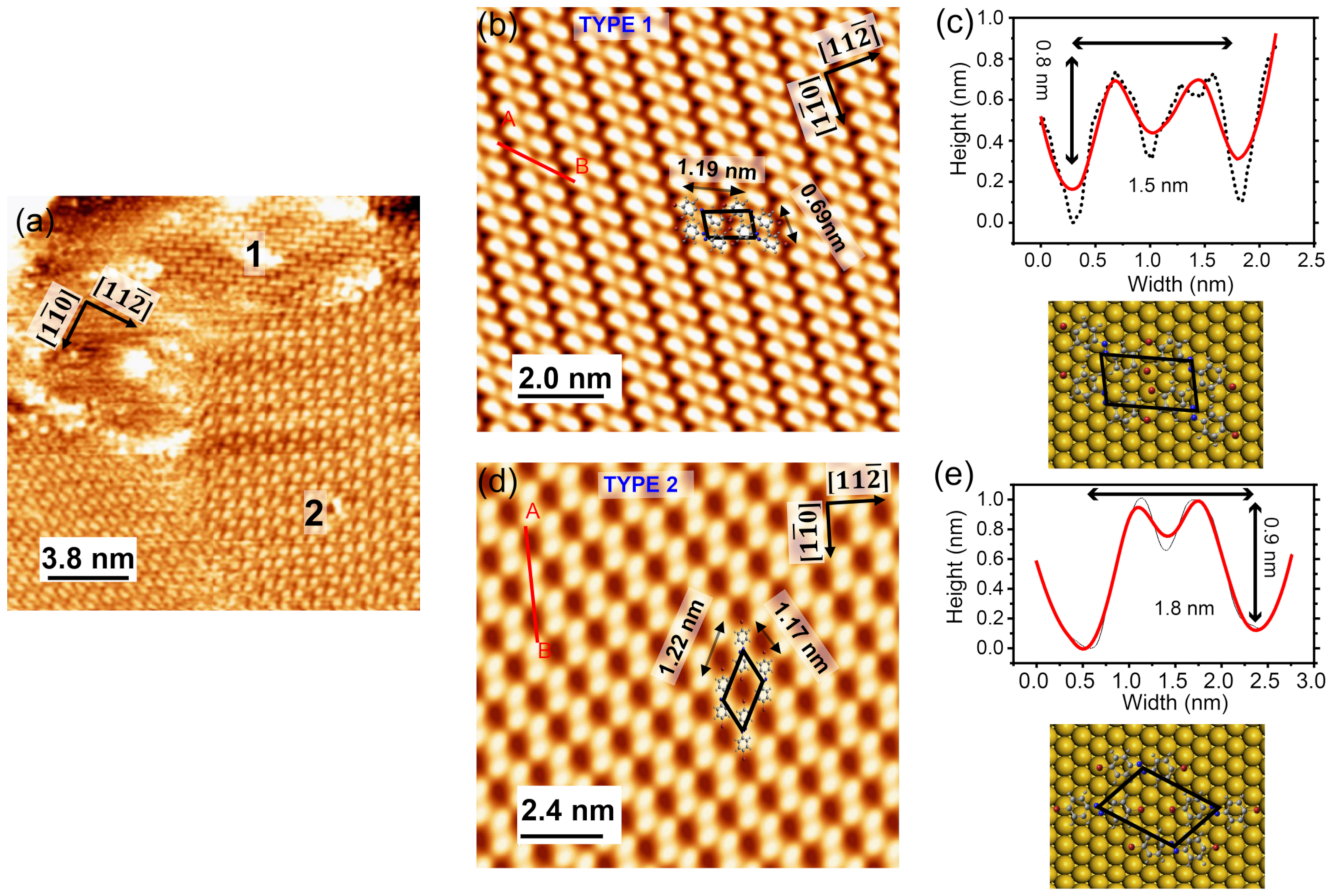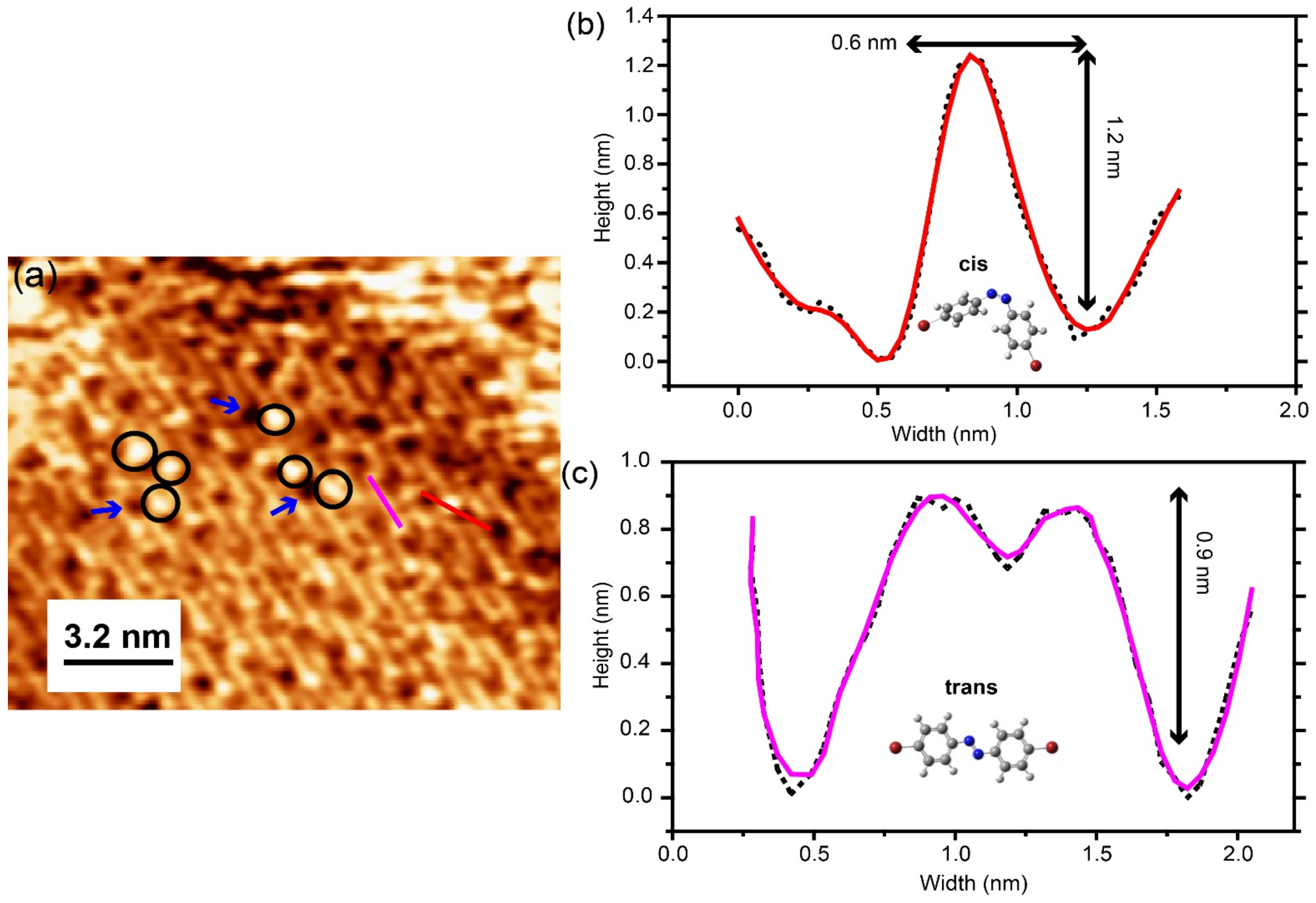Supramolecular Self-Assembly and Photo-Induced Transition of a Halogenated Azo-Benzene Molecule on Au(111) Surface
Abstract
1. Introduction
2. Experiment and Results
3. Conclusions
Author Contributions
Funding
Data Availability Statement
Conflicts of Interest
References
- EllGarah, M.; Lipton-Duffin, J.; MacLeod, J.M.; Gutzler, R.; Palmino, F.; Luzet, V.; Chérioux, F.; Rosei, F. Self-Assembly of a Halogenated Molecule on Oxide-Passivated Cu(110). Chem. Asian J. 2013, 8, 1813–1817. [Google Scholar] [CrossRef] [PubMed]
- Barth, J.V.; Costantini, G.; Kern, K. Engineering atomic and molecular nanostructures at surfaces. Nature 2005, 437, 671–679. [Google Scholar] [CrossRef] [PubMed]
- Green, J.E.; Wook Choi, J.; Boukai, A.; Bunimovich, Y.; Johnston-Halperin, E.; DeIonno, E.; Luo, Y.; Sheriff, B.A.; Xu, K.; Shik Shin, Y.; et al. A 160-kilobit molecular electronic memory patterned at 1011 bits per square centimetre. Nature 2007, 445, 414–417. [Google Scholar] [CrossRef] [PubMed]
- Rosei, F.; Schunack, M.; Naitoh, Y.; Jiang, P.; Gourdon, A.; Laegsgaard, E.; Stensgaard, I.; Joachim, C.; Besenbacher, F. Properties of large organic molecules on metal surfaces. Prog. Surf. Sci. 2003, 71, 95–146. [Google Scholar] [CrossRef]
- Fan, Z.; Zou, Y.; Liu, C.; Xiang, S.; Zhang, Z. Hydrogen-Bonded Organic Frameworks: Functionalized Construction Strategy by Nitrogen-Containing Functional Group. Chem. A Eur. J. 2022, 28, e202200422. [Google Scholar] [CrossRef]
- Shen, B.; Chen, X.; Wang, H.; Xiong, H.; Bosch, E.G.T.; Lazić, I.; Cai, D.; Qian, W.; Jin, S.; Liu, X.; et al. A single-molecule van der Waals compass. Nature 2021, 592, 541–544. [Google Scholar] [CrossRef]
- Szell, P.M.J.; Zablotny, S.; Bryce, D.L. Halogen bonding as a supramolecular dynamics catalyst. Nat. Commun. 2019, 10, 916. [Google Scholar] [CrossRef]
- Gutzler, R.; Fu, C.; Dadvand, A.; Hua, Y.; MacLeod, J.M.; Rosei, F.; Perepichka, D.F. Halogen bonds in 2D supramolecular self-assembly of organic semiconductors. Nanoscale 2012, 4, 5965. [Google Scholar] [CrossRef]
- Liu, J.; Abel, M.; Lin, N. On-Surface Synthesis: A New Route Realizing Single-Layer Conjugated Metal–Organic Structures. J. Phys. Chem. Lett. 2022, 13, 1356–1365. [Google Scholar] [CrossRef]
- El Garah, M.; Makoudi, Y.; Duverger, É.; Palmino, F.; Rochefort, A.; Chérioux, F. Large-Scale Patterning of Zwitterionic Molecules on a Si(111)-7 × 7 Surface. ACS Nano 2011, 5, 424–428. [Google Scholar] [CrossRef]
- Bartels, L. Tailoring molecular layers at metal surfaces. Nat. Chem. 2010, 2, 87–95. [Google Scholar] [CrossRef]
- Qiu, X.H. Vibrationally Resolved Fluorescence Excited with Submolecular Precision. Science 2003, 299, 542–546. [Google Scholar] [CrossRef]
- Zhang, Y.; Luo, Y.; Zhang, Y.; Yu, Y.-J.; Kuang, Y.-M.; Zhang, L.; Meng, Q.-S.; Luo, Y.; Yang, J.-L.; Dong, Z.-C.; et al. Visualizing coherent intermolecular dipole–dipole coupling in real space. Nature 2016, 531, 623–627. [Google Scholar] [CrossRef]
- Ijaz, T.; Yang, B.; Wang, R.; Zhu, J.; Farrukh, A.; Chen, G.; Franc, G.; Zhang, Y.; Gourdon, A.; Dong, Z. Self-decoupled tetrapodal perylene molecules for luminescence studies of isolated emitters on Au(111). Appl. Phys. Lett. 2019, 115, 173101. [Google Scholar] [CrossRef]
- Miwa, J.A.; Cicoira, F.; Lipton-Duffin, J.; Perepichka, D.F.; Santato, C.; Rosei, F. Self-assembly of rubrene on Cu(111). Nanotechnology 2008, 19, 424021. [Google Scholar] [CrossRef]
- Hu, J.; Hu, J.; Wang, H.; Shen, K.; Zhang, H.; Huang, C.; Xie, L.; Tian, Q.; Huang, H.; Jiang, Z.; et al. Initiating Ullmann-like coupling of Br2Py by a semimetal surface. Sci. Rep. 2021, 11, 3414. [Google Scholar] [CrossRef]
- Comstock, M.J.; Levy, N.; Kirakosian, A.; Cho, J.; Lauterwasser, F.; Harvey, J.H.; Strubbe, D.A.; Fréchet, J.M.J.; Trauner, D.; Louie, S.G.; et al. Reversible Photomechanical Switching of Individual Engineered Molecules at a Metallic Surface. Phys. Rev. Lett. 2007, 99, 038301. [Google Scholar] [CrossRef]
- Wakayama, Y.; Hayakawa, R.; Seo, H.-S. Recent progress in photoactive organic field-effect transistors. Sci. Technol. Adv. Mater. 2014, 15, 024202. [Google Scholar] [CrossRef]
- Alemani, M.; Selvanathan, S.; Ample, F.; Peters, M.V.; Rieder, K.-H.; Moresco, F.; Joachim, C.; Hecht, S.; Grill, L. Adsorption and Switching Properties of Azobenzene Derivatives on Different Noble Metal Surfaces: Au(111), Cu(111), and Au(100). J. Phys. Chem. C 2008, 112, 10509–10514. [Google Scholar] [CrossRef]
- Kumar, A.S.; Ye, T.; Takami, T.; Yu, B.-C.; Flatt, A.K.; Tour, J.M.; Weiss, P.S. Reversible Photo-Switching of Single Azobenzene Molecules in Controlled Nanoscale Environments. Nano Lett. 2008, 8, 1644–1648. [Google Scholar] [CrossRef]
- Henzl, J.; Mehlhorn, M.; Gawronski, H.; Rieder, K.-H.; Morgenstern, K. Reversiblecis-trans Isomerization of a Single Azobenzene Molecule. Angew. Chem. Int. Ed. 2006, 45, 603–606. [Google Scholar] [CrossRef] [PubMed]
- Yang, F.; Li, C.; Lai, W.; Zhang, A.; Huang, H.; Li, W. Halogenated conjugated molecules for ambipolar field-effect transistors and non-fullerene organic solar cells. Mater. Chem. Front. 2017, 1, 1389–1395. [Google Scholar] [CrossRef]
- Han, Z.; Czap, G.; Chiang, C.; Xu, C.; Wagner, P.J.; Wei, X.; Zhang, Y.; Wu, R.; Ho, W. Imaging the halogen bond in self-assembled halogenbenzenes on silver. Science 2017, 358, 206–210. [Google Scholar] [CrossRef] [PubMed]
- Muždalo, A.; Saalfrank, P.; Vreede, J.; Santer, M. Cis -to- Trans Isomerization of Azobenzene Derivatives Studied with Transition Path Sampling and Quantum Mechanical/Molecular Mechanical Molecular Dynamics. J. Chem. Theory Comput. 2018, 14, 2042–2051. [Google Scholar] [CrossRef] [PubMed]
- Dias, A.R.; Minas Da Piedade, M.E.; Martinho Simões, J.A.; Simoni, J.A.; Teixeira, C.; Diogo, H.P.; Meng-Yan, Y.; Pilcher, G. Enthalpies of formation of cis-azobenzene and trans-azobenzene. J. Chem. Thermodyn. 1992, 24, 439–447. [Google Scholar] [CrossRef]
- Bandara, H.M.D.; Burdette, S.C. Photoisomerization in different classes of azobenzene. Chem. Soc. Rev. 2012, 41, 1809–1825. [Google Scholar] [CrossRef]
- Zhen, R.; Lu, W.; Zhou, Y.; Feng, M.; Wang, Y. Synthesis and Characterization of 4,4′-Dibromoazobenzene. Org. Polym. Mater. Res. 2020, 1, 6–8. [Google Scholar] [CrossRef]
- Zhao, J.; Zhang, Y.; Gan, L.; Wang, G. Experimental and DFT study of UV–vis absorption spectra of azobenzene containing ester groups. Comput. Theor. Chem. 2021, 1200, 113244. [Google Scholar] [CrossRef]
- Cho, E.N.; Zhitomirsky, D.; Han, G.G.D.; Liu, Y.; Grossman, J.C. Molecularly Engineered Azobenzene Derivatives for High Energy Density Solid-State Solar Thermal Fuels. ACS Appl. Mater. Interfaces 2017, 9, 8679–8687. [Google Scholar] [CrossRef]
- Kirakosian, A.; Comstock, M.J.; Cho, J.; Crommie, M.F. Molecular commensurability with a surface reconstruction: STM study of azobenzene on Au(111). Phys. Rev. B 2005, 71, 113409. [Google Scholar] [CrossRef]
- McNellis, E.R.; Meyer, J.; Reuter, K. Azobenzene at coinage metal surfaces: Role of dispersive van der Waals interactions. Phys. Rev. B 2009, 80, 205414. [Google Scholar] [CrossRef]
- Zhang, X.; Shen, Q.; Ding, H.; Chen, X.; Yang, H.; Li, B.; Liu, X.; Lin, H.; Li, Q.; Gao, J.; et al. On-Surface Synthesis of Thiophene-Containing Large-Sized Organometallic Macrocycles on the Ag(111) Surface. J. Phys. Chem. C 2021, 125, 11454–11461. [Google Scholar] [CrossRef]
- Pechenezhskiy, I.V.; Cho, J.; Nguyen, G.D.; Berbil-Bautista, L.; Giles, B.L.; Poulsen, D.A.; Fréchet, J.M.J.; Crommie, M.F. Self-Assembly and Photomechanical Switching of an Azobenzene Derivative on GaAs(110): Scanning Tunneling Microscopy Study. J. Phys. Chem. C 2012, 116, 1052–1055. [Google Scholar] [CrossRef]
- Weigelt, S.; Busse, C.; Petersen, L.; Rauls, E.; Hammer, B.; Gothelf, K.V.; Besenbacher, F.; Linderoth, T.R. Chiral switching by spontaneous conformational change in adsorbed organic molecules. Nat. Mater. 2006, 5, 112–117. [Google Scholar] [CrossRef]
- Henzl, J.; Morgenstern, K. The frontier orbitals of a push-pull azobenzene adsorbed on a metal surface in different bonding geometries investigated by scanning tunneling spectroscopy and spectroscopy mapping. J. Chem. Phys. 2011, 135, 094702. [Google Scholar] [CrossRef]
- Choi, B.-Y.; Kahng, S.-J.; Kim, S.; Kim, H.; Kim, H.W.; Song, Y.J.; Ihm, J.; Kuk, Y. Conformational Molecular Switch of the Azobenzene Molecule: A Scanning Tunneling Microscopy Study. Phys. Rev. Lett. 2006, 96, 156106. [Google Scholar] [CrossRef]
- Qiu, X.H.; Nazin, G.V.; Ho, W. Mechanisms of Reversible Conformational Transitions in a Single Molecule. Phys. Rev. Lett. 2004, 93, 196806. [Google Scholar] [CrossRef]
- Alemani, M.; Peters, M.V.; Hecht, S.; Rieder, K.-H.; Moresco, F.; Grill, L. Electric Field-Induced Isomerization of Azobenzene by STM. J. Am. Chem. Soc. 2006, 128, 14446–14447. [Google Scholar] [CrossRef]
- Levy, N.; Comstock, M.J.; Cho, J.; Berbil-Bautista, L.; Kirakosian, A.; Lauterwasser, F.; Poulsen, D.A.; Fréchet, J.M.J.; Crommie, M.F. Self-Patterned Molecular Photoswitching in Nanoscale Surface Assemblies. Nano Lett. 2009, 9, 935–939. [Google Scholar] [CrossRef]




Disclaimer/Publisher’s Note: The statements, opinions and data contained in all publications are solely those of the individual author(s) and contributor(s) and not of MDPI and/or the editor(s). MDPI and/or the editor(s) disclaim responsibility for any injury to people or property resulting from any ideas, methods, instructions or products referred to in the content. |
© 2023 by the authors. Licensee MDPI, Basel, Switzerland. This article is an open access article distributed under the terms and conditions of the Creative Commons Attribution (CC BY) license (https://creativecommons.org/licenses/by/4.0/).
Share and Cite
Ijaz, T.; Zhang, X.; Chen, X.; Xing, X.; Fang, S.; Liu, M.; Lu, H.; Li, F.; Gao, J.; Pan, M. Supramolecular Self-Assembly and Photo-Induced Transition of a Halogenated Azo-Benzene Molecule on Au(111) Surface. Crystals 2023, 13, 404. https://doi.org/10.3390/cryst13030404
Ijaz T, Zhang X, Chen X, Xing X, Fang S, Liu M, Lu H, Li F, Gao J, Pan M. Supramolecular Self-Assembly and Photo-Induced Transition of a Halogenated Azo-Benzene Molecule on Au(111) Surface. Crystals. 2023; 13(3):404. https://doi.org/10.3390/cryst13030404
Chicago/Turabian StyleIjaz, Talha, Xin Zhang, Xiaorui Chen, Xueting Xing, Simin Fang, Mengyuan Liu, Huan Lu, Fangsen Li, Jianzhi Gao, and Minghu Pan. 2023. "Supramolecular Self-Assembly and Photo-Induced Transition of a Halogenated Azo-Benzene Molecule on Au(111) Surface" Crystals 13, no. 3: 404. https://doi.org/10.3390/cryst13030404
APA StyleIjaz, T., Zhang, X., Chen, X., Xing, X., Fang, S., Liu, M., Lu, H., Li, F., Gao, J., & Pan, M. (2023). Supramolecular Self-Assembly and Photo-Induced Transition of a Halogenated Azo-Benzene Molecule on Au(111) Surface. Crystals, 13(3), 404. https://doi.org/10.3390/cryst13030404




